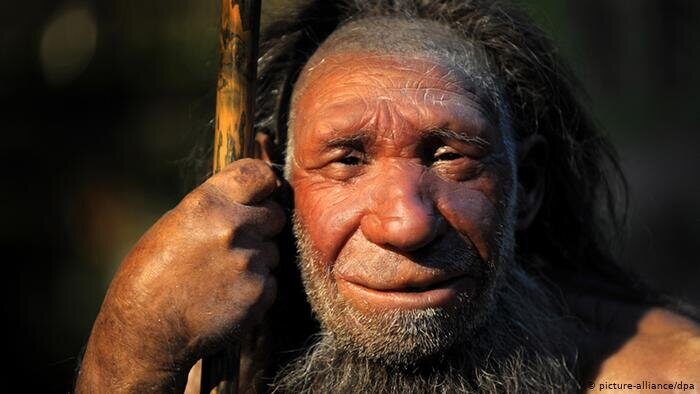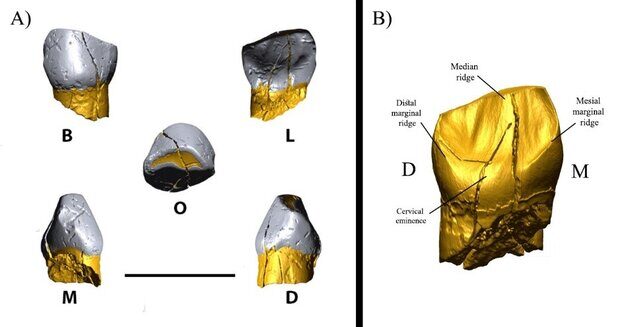The research is described in a paper in the online journal PLOS ONE that was published last Thursday. The tooth, which is a lower left deciduous canine that belongs to a 6 years old child, was found at a depth of 2.5 m from the surface of the Bawa Yawan shelter in association with animal bones and stone tools near Kermanshah.
Performed by senior Iranian archaeologist Saman Heydari-Guran based in the Neanderthal Museum in Mettmann, and his international fellows such as Stefano Benazzi, who is a physical anthropologist at the University of Bologna, analysis shows that the tooth has Neanderthal affinities.
Stone tools discovered close to the tooth belong to the Middle Paleolithic period and a series of C14 dating suggests the Neanderthal is between 41,000-43,000 years in age which is close to the end of the Middle Paleolithic period when Neanderthal disappeared in the Zagros.
"Neanderthal extinction has been a matter of debate for many years. New discoveries, better chronologies, and genomic evidence have done much to clarify some of the issues. This evidence suggests that Neanderthals became extinct around 40,000-37,000 years before the present (BP), after a period of coexistence with Homo sapiens of several millennia, involving biological and cultural interactions between the two groups.
Comment: Research shows that the biological interaction was limited to a 'handful' of intimate relations.
However, the bulk of this evidence relates to Western Eurasia, and recent work in Central Asia and Siberia has shown that there is considerable local variation. Southwestern Asia, despite having a number of significant Neanderthal remains, has not played a major part in the debate over extinction" says Heydari-Guran who leads the Bawa Yawan excavation project.
In a review of the present study, Fereidoun Biglari, a Paleolithic archaeologist at Iran National Museum, has said: "This recent discovery, along with other Neanderthal remains previously found in other parts of Zagros, including Shanidar Cave, Bisotun Cave, and Wezmeh Cave, indicate that Neanderthals were present in a wide geographical range of Zagros from northwest to west of this mountain range since at least 80,000 until about 40,000-45,000 years ago when they disappeared and Homo Sapiens populations spread into the region".
The Bawa Yawan is the second Neanderthal tooth that has been discovered in Iran. The first Neanderthal tooth was discovered in the Wezmeh cave near Kermanshah in 2001.
Moreover, the discovery of the third tooth of the Neanderthal child was announced by a joint Iranian-French team that was discovered in Qal-e Kord near Qazvin in 2019. These discoveries show that Iran has a rich paleoanthropological record and the country can produce important data in the future.





All done to fit their narrative.
That's the main problem I have with this dating science, why? Why is it important? All I can see as it's main goal is to change our belief's in how old we are and how we were not created, but evolved. Evolution, after all is just a theory and it's not proven fact. In order to make it look like a fact, you need to change the history to fit the theory. That's what I am seeing happening.
I think RC made a comment earlier today about books, and that Law books are expensive. That got me thinking, when reading this story. So here's my theory on books and tech of the past, true speculation.
If you believe in the flood as explained in the Bible, then you must believe in a preflood civilization. If the Bible later tells us about the end times and references "as in the days of Noah", which I believe us to be in, then it stands to reason (theory) that there were books preflood. It stands to reason that they were as smart, if not smarter than we are today (simply because of the longer lives and less corrupt gene pool = more knowledgeable). The fallen angels taught us and corrupted us mentally and genetically as well. The possibility also exists that they had technology, similar to what we have today, implying computers and weapons and whatever. Science today, wants us to believe in a slow geologic process, but the other side of the coin says that sometimes processes happen quickly, like volcanoes blowing up. They also make us believe, the flood was just that and that the earth was covered in water. Sounds simple, but there was also geologic processes (movement of continents, creation of mountains) with the flood. So where are all the books? Paper can't withstand water. Paper can't be buried in mud and survive. Any electronics would corrode away and buried (not gradually, but catastrophically). Where are the stats/odds of finding that? Sure we see stone structures of the past, stone tools, but iron does corrode. Plastics where are they, what if they degenerate quicker than we realize, what if they never really used plastics like we do, since 500 years before the flood it was a pretty violent time. Hence we are only left with stones and organic fossils. The possibility also exists that any technology could simply be buried, where we are not looking (deep under the ocean floor or deep inside the biggest mountains. There are too many possibilities as the earth is a big place. What is really happening in Antarctica anyways, why the smoke and mirrors surrounding that place?
Something to think about and I've always thought about it, even when I believed science more than I believe it today. Todays discoveries are always pigeon holed into the latest theory, ignoring too many oddities, to make the theories be sound. If you believe in God and the Bible, why is it so hard to just believe what was written? Why question God's word? Why change the history he gave us? There are other books, that were not included in the Bible, why? Some are not complete (Book of Giants) and others are (Book of Enoch). They all paint a not so nice picture of the preflood and they all speak of things the writers could only describe to the best of their abilities and knowledge of their time, when they were inspired by God to write about it. Think of one of the primitive tribes people living in the south Pacific. Drag one of them to New York City for a couple of hours, then sit them down with pen and paper and tell them to write what they saw. Bet they would describe what they saw differently than how we understand it really is.
Anyways, that's my food for thought theory to counteract against these "Theories we are made to believe are true".
JTFT